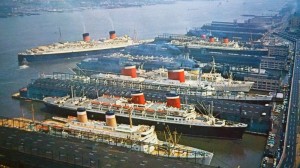 With the emergence of advancing technology, ships became larger, faster and more luxurious. The well-known story of the RMS Titanic-disaster only temporarily interrupted the confidence passengers came to have about safety. Within twenty years much larger and far more luxurious liners like the RMS Queen Mary, the RMS Queen Elizabeth and SS Normandie all contributed to making the ocean liner industry indispensable, glamorous and the envy of everyone who dreamed about romance, fashion and high society.
With the emergence of advancing technology, ships became larger, faster and more luxurious. The well-known story of the RMS Titanic-disaster only temporarily interrupted the confidence passengers came to have about safety. Within twenty years much larger and far more luxurious liners like the RMS Queen Mary, the RMS Queen Elizabeth and SS Normandie all contributed to making the ocean liner industry indispensable, glamorous and the envy of everyone who dreamed about romance, fashion and high society.